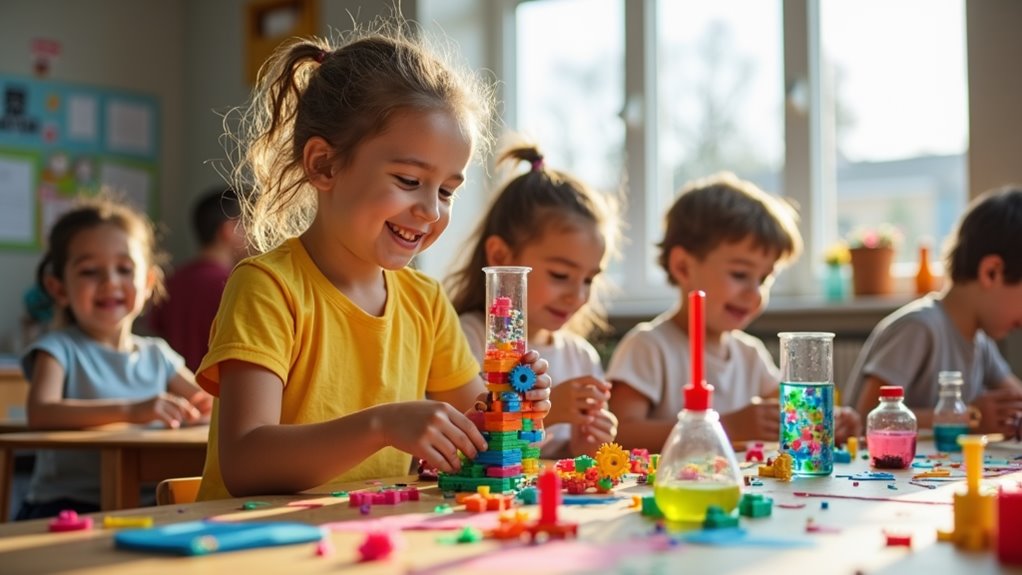Got kids who love to explore? Fun STEM activities are a perfect way to engage their minds! You can build a simple robot from cardboard or create a mini volcano eruption with baking soda and vinegar. Want to combine play with learning? Try coding games on Scratch or tackle an engineering challenge to build spaghetti towers. Nature lovers can enjoy bug hunts or craft with recycled materials to make awesome art. These activities spark curiosity and build essential skills. Curious about more ways to keep those young minds buzzing? There's plenty more exciting stuff to discover!
Importance of STEM Education
STEM education is crucial because it equips kids with essential skills for the future. You might wonder why it matters so much. Well, STEM stands for Science, Technology, Engineering, and Math, and these subjects help you understand the world around you.
Whether you're figuring out how to launch a paper rocket or trying to solve a puzzle, you're using critical thinking!
When you immerse yourself in STEM learning, you're not just memorizing facts; you're developing problem-solving skills. Imagine being a detective, piecing together clues to crack a case—sounds fun, right?
Plus, you get to explore creativity! You can design experiments, build models, or even create apps.
STEM also prepares you for many careers. In our tech-driven world, jobs in these fields are booming.
Building a Simple Robot
With a little imagination and some basic materials, you can build a simple robot that brings your ideas to life. Grab some cardboard, scissors, and a few small motors or servos—your robot's about to get moving!
First, sketch out what you want your robot to look like. Is it a friendly helper or a speedy racer? Once you have a design, cut out your robot's body from the cardboard.
Next, attach the motors; this is where the magic happens! Connect the motors to a battery pack and make sure everything's secure. Don't forget to give your robot some personality—add googly eyes or colorful stickers.
Now, it's time to program it! If you're using a microcontroller like Arduino, download the software, and follow some simple coding tutorials. You'll be amazed at how easy it's to make your robot dance, move, or even respond to your commands.
And remember, if something doesn't work out the first time, don't worry! Every great inventor has had their share of "oops" moments.
DIY Volcano Eruption Experiment
You can create your own exciting DIY volcano eruption experiment with just a few simple materials found around the house. To start, you'll need a small plastic bottle, baking soda, vinegar, food coloring, and some dish soap. Get ready for a bubbly explosion!
First, place the bottle on a tray or a large plate to catch any mess. Fill the bottle about a third of the way with baking soda. Then, add a squirt of dish soap and a few drops of food coloring—pick your favorite color! This is where the fun begins.
Now, it's time for the grand finale! Slowly pour vinegar into the bottle and watch as your volcano erupts with colorful fizz. The reaction between the baking soda and vinegar creates carbon dioxide gas, which causes the bubbling action, resembling a real lava flow.
If you want to take it up a notch, try experimenting with different amounts of baking soda and vinegar to see how it affects the eruption.
Share your results with friends and family—they'll be amazed! This experiment isn't just fun; it's a great way to learn about chemical reactions. Happy erupting!
Exploring Coding With Games
After the excitement of your DIY volcano eruption, it's time to explore another thrilling aspect of STEM: coding through games. You might be wondering, "How can coding be fun?" Well, think of it like creating your own adventure! With coding games, you get to be the designer, storyteller, and hero all at once.
Start by checking out platforms like Scratch or Code.org. They offer colorful, interactive games where you can drag and drop blocks to create your own animations or games. Imagine programming a character to jump over obstacles or dance to music! It's like playing with digital LEGO blocks.
You'll also find games like LightBot or CodeCombat that teach you to solve puzzles using coding concepts. As you solve each challenge, you'll feel like a coding wizard.
And don't forget, making mistakes is part of the learning process—so embrace them!
As you plunge into coding, remember it's not just about getting the code right; it's about sparking your creativity. So, grab your keyboard, and let's start coding your way to fun! Who knows, you might just invent the next big game!
Creating a Miniature Garden
Creating a miniature garden can be a delightful way to bring a bit of nature indoors or enhance your outdoor space. You don't need a green thumb to get started; just a little creativity and a few supplies!
First, choose a container. It could be anything from a small pot to a wooden box or even an old shoe—just make sure it has drainage holes.
Next, select your plants. Tiny succulents, colorful flowers, or even herbs work great. Think about how you want your garden to look. Do you want it to feel like a tropical paradise or a fairy tale forest?
You can add fun decorations too! Consider small figurines, pebbles, or even toy animals to give it personality.
Now, it's planting time! Fill your container with soil, place your plants, and don't forget to water them lightly.
Once your garden is set up, watch how it grows and changes. It's like having a little world of your own. Plus, caring for your garden teaches responsibility and science.
Fun With Physics: Balloon Rockets
Balloon rockets are a thrilling way to explore the principles of physics while having a blast! You'll need just a few simple materials: a balloon, some string, and a straw.
First, stretch out the balloon and blow it up without tying it. Now, don't let it go yet; that's the fun part!
Next, thread the straw onto the string, which you should tie between two objects, like chairs. Secure the string so it's taut. Hold the inflated balloon at one end of the straw and let it go. Whoosh! The air escaping the balloon pushes it forward, demonstrating Newton's third law of motion: for every action, there's an equal and opposite reaction. Pretty cool, huh?
You can try different balloon sizes, change the amount of air, or even race against friends. Each change helps you see how physics works in real life.
Just remember, the more air you have, the faster your rocket will zoom! So, grab those balloons and get ready to blast off. You're not just having fun; you're becoming a physics whiz in the process!
Chemistry Magic: Color Changing Milk
While you might think milk is just for drinking, it can also be the star of an enchanting science experiment! Get ready to immerse yourself in the magical world of color-changing milk. All you need is a shallow dish, some milk, food coloring, and dish soap. Sounds simple, right?
First, pour a layer of milk into your dish. Then, drop a few drops of different food coloring around the milk's surface.
Now, here comes the fun part! Dip a cotton swab into the dish soap, and gently touch it to the milk. Watch in amazement as the colors swirl and dance like they're at a party!
What's happening here? The dish soap breaks down the fat in the milk, causing the colors to spread rapidly. It's like a science magic trick right before your eyes!
You can try using different types of milk, too—see how the results change!
Engineering Challenge: Spaghetti Tower
After experiencing the colorful wonders of chemistry with your milk experiment, it's time to shift gears and put your engineering skills to the test. Get ready for the Spaghetti Tower challenge! This activity isn't only fun, but it also lets you flex those creative problem-solving muscles.
Here's what you need: a bundle of uncooked spaghetti, some marshmallows, or tape, and a bit of imagination. Your goal? Build the tallest tower you can, using only those materials.
Start by brainstorming how to create a strong base—remember, a sturdy foundation is key to any great structure!
As you build, you'll discover which shapes are the most stable and why some designs wobble. It's like a mini physics lesson wrapped in a tasty treat!
Don't be afraid to try different approaches. If your tower comes crashing down, just laugh it off and give it another shot. Remember, every great engineer learns from their failures.
At the end, measure your tower and see how it compares to your friends'. Who knew spaghetti could be so much fun? Get ready to unleash your inner architect!
Math Games for Young Learners
In the world of early education, math games are a fantastic way to make learning numbers and concepts enjoyable for young learners. You can transform mundane math practice into a fun adventure with just a few simple activities. Think about using everyday items like dice, cards, or even snacks.
For example, create a race where kids roll dice and add the numbers to move along a game board. They'll hardly realize they're brushing up on addition!
You could also try a card game where players need to match numbers or create equations. The competition will spark excitement and keep everyone engaged. If you want to add a twist, use a timer for quick rounds, making kids think fast—who doesn't love a little friendly pressure?
Don't forget about online resources! Many websites offer interactive math games that adapt to different skill levels. This way, your child can learn at their own pace while enjoying colorful graphics and challenges.
Nature Science: Bug Exploration
If you're looking to spark your child's curiosity about the natural world, exploring bugs is a fantastic way to immerse yourself in nature science. Grab a magnifying glass and head outside!
You'll be amazed by the tiny creatures buzzing, crawling, and fluttering around you. Start with a bug hunt in your backyard or a local park. Encourage your child to observe different insects, noting their colors, sizes, and movements.
You can make it a scavenger hunt, giving them a list of bugs to find. Don't forget to bring a notebook! Jotting down observations can turn this fun adventure into a little science journal. Who knew that ladybugs and ants could be such fascinating subjects?
Afterward, you can research the bugs you've found together. What do they eat? Where do they live? Learning about their role in the ecosystem can open up discussions about nature and conservation.
And let's be honest—who doesn't giggle when they see a grasshopper jump?
Crafting With Recycled Materials
Exploring the world of bugs can inspire creativity, especially when it comes to using recycled materials for crafting. You can transform everyday items into amazing bug creations! Gather up some old cardboard tubes, bottle caps, and scrap paper, and let your imagination run wild.
Start by making a cool caterpillar. Use the cardboard tube as the body and paint it bright colors. Glue on some bottle caps for eyes, and don't forget to add pipe cleaners for antennas.
How about creating a butterfly? Cut out wings from colorful paper and decorate them with markers or stickers. Attach them to a stick or the same tube to make your butterfly fly!
As you craft, talk about what materials you're using and where they came from. It's a great way to think about recycling and how we can help the planet. Plus, you get to have fun while being eco-friendly!
When you finish your bug masterpieces, display them proudly or even organize a mini art show for your family. Who knew that recycling could be so much fun? So grab those materials and let the crafting adventure begin!





